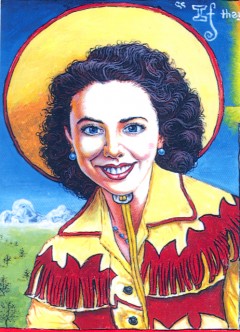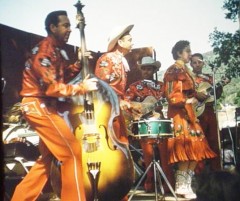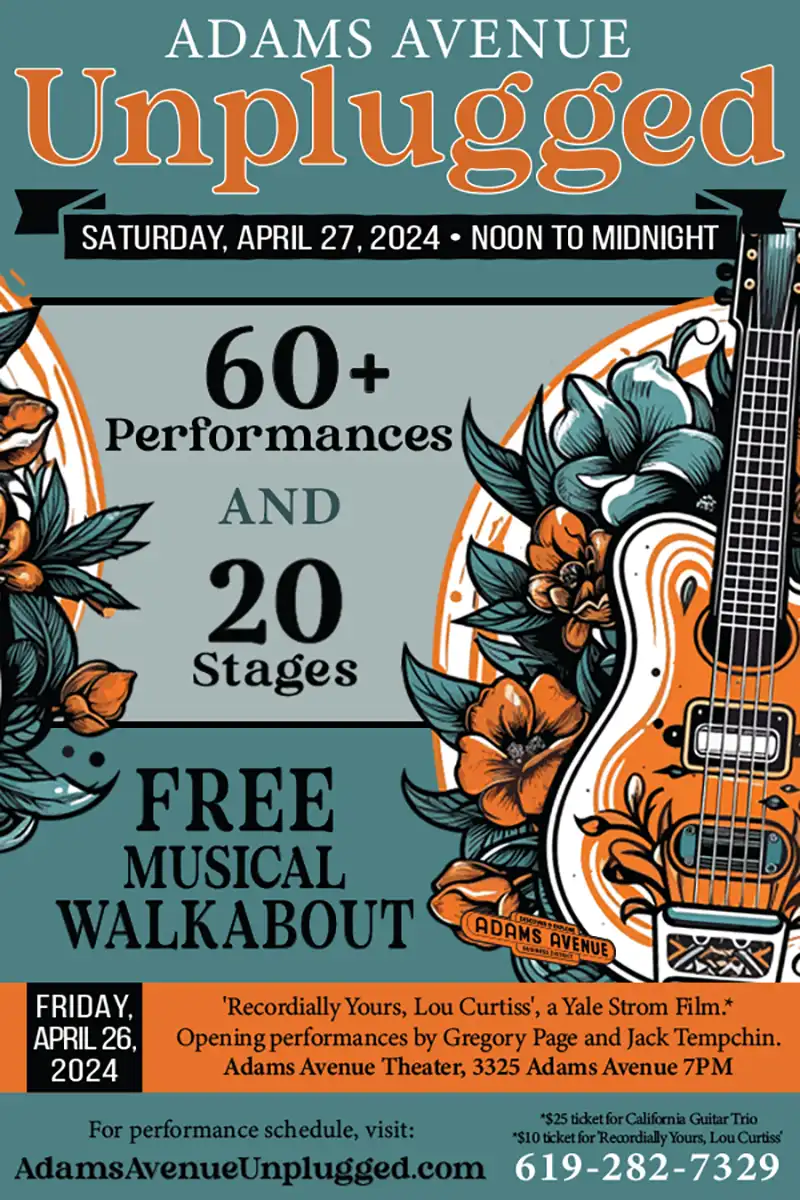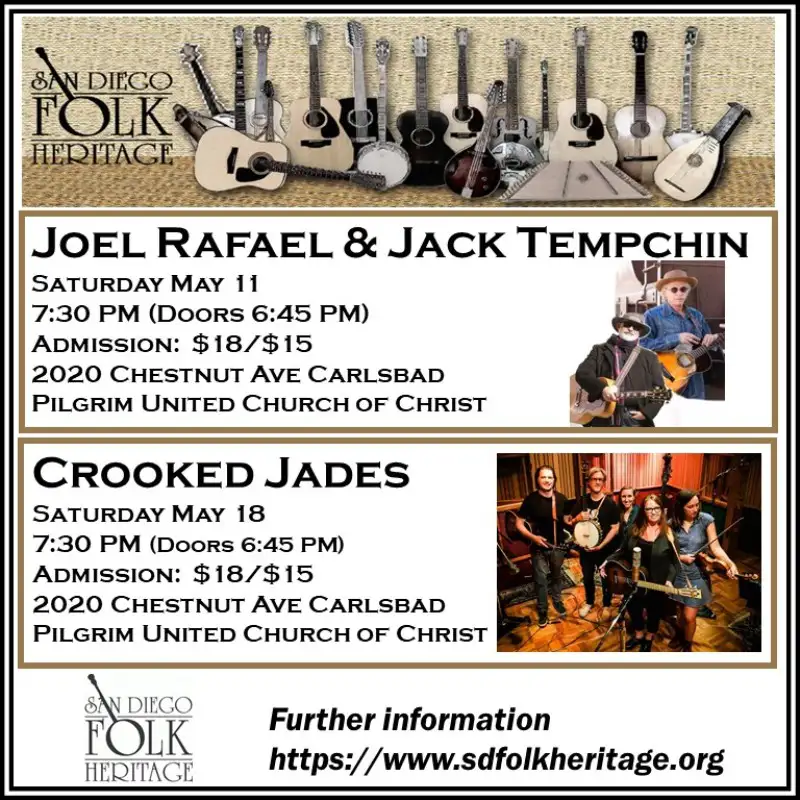Yesterday And Today
Queen of Hillbilly Swing: Rose Maddox, Part 2

Rose Maddox, Sweetheart of Hillbilly Swing

Maddox Brothers & Rose ca 1950.
PART 2
The war years of 1941-1945 proved to be defining ones for Rose. Her brothers Fred and Cal were drafted in early 1942. A shell of the Maddox Brothers and Rose continued with Don and, occasional band mate, brother Cliff. With Don on fiddle and Cliff on guitar, Rose played upright bass. Within a year, Don too was in the service. Cliff avoided military duty due to ongoing health problems. Mother Lula then thrust a mandolin into the hands of little brother Henry, and he was ordered to learn it.
Radio shows for the McClatchy network were put on hold, but this makeshift trio continued to find work playing the California club circuit. Rose was being forced into the forefront without the benefit and support of her regular bandmates. Nevertheless, she embraced the challenge. Rose would learn that she was a born performer, and not merely window dressing or a cute curiosity of the Maddox Brothers band. It was during this time that the increasingly eccentric Lula rushed the 16- year-old Rose into a disastrous marriage. The groom was army sergeant Enoch Byford Hale, or “E.B.”, a man several years her senior. Heretofore, jealously guarded by Lula, Rose was now being thrown into the deep end of a relationship that she was not prepared for and didn’t want. So protected had Rose been, that the evening before the wedding Lula and older sister Alta sat Rose down and gave her a crash course in her wifely honeymoon obligations. Rose was aghast at the idea–how could such things be! Eleven months after the marriage, Rose was with child. E.B. promptly blamed it on a neighbor and deserted his pregnant wife. Arguably, E.B. wasn’t anymore prepared for matrimony than Rose. Nine months later Rose gave birth to her only child, Donnie.
A short six months after her son’s birth Rose learned that Roy Acuff was in L.A. auditioning for a girl singer. She got an audition, but not the job. Soon thereafter she also tried out for Bob Wills’ Texas Playboys line up. Though well known by Wills, who had relocated to the San Fernando Valley during the war years, Rose was again rejected. Though not told at the time, this rejection was not based on any lack of talent or ability on her part. Wills knew that to get Rose he would also be getting the overbearing Lula. Shunned by national headliners like Acuff and Wills, the ever plucky Rose was sought out by regional acts like Arky Stark and Dave Stogner, but more for her considerable skills as a bass player, not as a group spark plug.
As professionally frustrating and personally painful as the war years were for Rose, her purpose and goals had come into focus. She was driven to make music and she knew it. She had also developed a confidence in her own ability to perform–with or without her brothers.
1945 brought the end to the war and the return of Fred, Cal, and Don. The family band was quickly resurrected. The new addition of Henry on mandolin made the band more potent than ever. The immediate post war years also brought new amplified instruments. Soon the Maddox Brothers and Rose were known as not only the most colorful hillbilly band but also the loudest. Its musical repertoire changed too. People wanted to dance, so the band abandoned its folksy roots and adopted a hot-rodded R&B sound. They augmented this sound with a succession of “hired hands”–steel guitarist Bud Duncan, guitarists Jimmy Winkle and Gene LeMasters, and even gave 16 year old Roy Nichols his first real gig. Nichols, master of the Telecaster, went on to become the cornerstone of the Bakersfield sound, backing such luminaries as Lefty Frizzell, Wynn Stewart, and Merle Haggard.
In 1946 the band was signed to 4-Star Records. This label was notorious for swindling artists. Still, the Maddox Brothers and Rose managed to use it to their own advantage. Then, as now, selling records was the goal. But the band’s strength rested in its ability as a LIVE act. None were stellar musicians, yet the band drew crowds in the thousands due to its on-stage antics. Early recordings sound undisciplined and raucous, while their jokes sounded embarrassingly corny. Still, the group had unquestionable timing and stage presence. Their contract with 4-Star became a way for the band to push its live performances and personal appearances. This became particularly true when the label managed to secure 15-minute transcripted radio shows aired nightly on XERB. This border radio giant, broadcasting out of Rosarita Beach, had the power to reach every nook and cranny of air space across the western U.S. The band used this situation to promote all their live shows. Lula certainly understood this fact and accordingly sold a fortune of sundry band paraphernalia at every show. In short order the band was motoring cross country in style in a fleet of four elegant, new Cadillacs and living in homes in Hollywood and Beverly Hills.
In February of 1949 the Maddox Brothers and Rose were big enough to appear on the Grand Ole Opry. Indeed, reputation proved bigger than record sales, but the band couldn’t be ignored. California at that time was equally as viable in its representation of country music as was Nashville. What should have been a healthy rivalry between the two regions would turn into a bitter winner-take-all war in a few short years. The West Coast had produced such stars as Gene Autry, Tex Ritter, Spade Cooley, Merle Travis, and Tex Williams. These entertainers and artists shared equal star billing with the Opry’s Roy Acuff, Ernest Tubb, and Red Foley. What gave Nashville its ultimate edge was Hank Williams’ Opry debut in June, 1949. Distrust and misgivings about the band’s only Opry appearance were mutual, and it was never asked back, while the band didn’t care to return. It found Opry musicians snobbish and its reception less than warm by the powers that be. So much for Southern hospitality!
The band’s colorful Nathan Turk duds and their showmanship proved, once again, that this was an outfit geared for live performance, not recording. In 1953 the band left 4-Star for Columbia. Although there was no marked bump in record sales with the move, the big label name did open doors. Rejected by the Opry, they nevertheless became stars on other regional live radio shows–Louisiana Hay Ride, Hometown Jamboree, and Town Hall Party. They blazed a trail across television, radio, and on jukeboxes nationwide. Since they were everywhere across the broadcast media, ironically they hurt their record sales even further. Economics 101 teaches that measured scarcity of a commodity makes it more valued. The band was anything but scarce, so why buy the cow when you get the milk for free?
Rock ‘n’ roll and the new direction in country music also took its toll. Arguably, the band has been credited for birthing the rockabilly school of rock ‘n’ roll. For years they had blended country and R&B. Adding
Fred Maddox’s slap-styled bass and Rose’s wiggling and jiggling, the band had been doing rockabilly ten years before Elvis. But popular focus was on the headliner–the Hank Williams, the Elvis, the Buddy Holly. The band concept was minimized and would remain so until the Beatles. The only person with that name recognition and star potential in the Maddox Brothers and Rose was Rose herself. In fact, she already had a solo contract with Columbia, concurrent with that of the band.
1956 marked the end of the Maddox Brothers and Rose as a band. It also marked the beginning of an uncompromised solo career for Rose. Except for Fred, all the brothers were ready to try their hand at something else. Fred, Don, and Henry would continue to find work up and down the coast for a few more years. They even made an ill-fated attempt at replacing Rose with Henry’s wife Retta. But without Rose the spark was gone. Lula would continue to shadow Rose, who would retain brother Cal on guitar. Now all eyes were on Rose.
In 1956 Rose scored a smash hit with the song “I Love a Tall Man.” Momentum from the record was so substantial that Rose was invited to guest on the Grand Ole Opry. Dressed in a provocative cowgirl outfit to match the slightly naughty lyrics of the song, Rose worked the audience into a tizzy while the conservative Opry managers went apoplectic. Rose was an instant Opry sensation and soon became a member of the show’s cast of stars. Rose, Cal, and Lula set up residence in Nashville. She was performing every Friday and Saturday night for the regional Opry T.V. show. It wasn’t long, however, before she was pulled from these appearances resulting from Opry politics and jealousies centering around her new-found popularity. Rose and family jumped in their Cadillac and Cal drove them back to California.
On her return to California Rose attempted to expand her artistic parameters by recording a pop, a gospel, and even a bluegrass album with Bill Monroe. Rose was proud of the results, but rather than enlarging her audience, it appears that she only confused radio program directors. Adding further trauma to this chaotic period was her son, Donnie. Now in his teens, the boy had been raised in a succession of boarding schools and summer camps. He was ready to come home, but Rose wasn’t. At this time brother Don had bought a cattle ranch in Ashland, Oregon. Donnie went to live at his uncle’s spread. At least for the time being, this would provide a temporary solution in dealing with her increasingly rebellious son.
A much more difficult situation than her son was that of her mother. Without the band, Rose became the focus of all of Lula’s control and eccentricities. The final painful break came in 1958. Rose had met Jimmy Brogdon, owner of the Wheel Club in Oceanside. Brogdon was well connected in the music industry and his club regularly hosted such luminaries as George Jones, Johnny Cash, Willie Nelson, Roger Miller, and the up-and-coming Merle Haggard. Brogdon would now host another star: Rose. It didn’t take long before Brogdon and Rose were in love. To Lula, this was a tabu of the highest order. Despite Lula’s threats, the couple married in 1959. A bitter, angry, and irreconcilable Lula was finally forced out of her daughter’s life, joining Donnie on Don’s cattle ranch.
1959 also brought an end to Rose’s contract with Columbia. She was quickly snapped up by Capitol, a country friendly label at the time. In short order, Capitol quickly released her first single, “What Makes Me Hang Around?” with flip side “Gambler’s Love.” While Nashville producers like Chet Atkins were sanitizing country music with lush production, Rose’s producer at Capitol, Ken Nelson, gave Rose free reign. Guys like Nelson understood that a battle was raging for the heart and soul of country music. It was the Nashville sound versus that of the West Coast, or more specifically, the Bakersfield sound, which was rowdy, with the metallic bite of a Fender Telecaster and the punch of drums and bass, accented with pedal steel guitar. Artists like Rose, Red Simpson, Wynn Stewart, Tommy Collins, Buck Owens, and Merle Haggard campaigned for this hard-scrabble sound. These folks could play a joint like Blackboard Cafe on a Friday or Saturday night to a pack of hell-raising ranch hands and roughnecks, then come Monday record the same music without reservation. Moreover, these artists were willing underdogs in this fight.
In 1963 Cashbox magazine named Rose Top Female Country Vocalist. All the years of hard work had paid off, but on the down side it was taking its toll. Extended time away from home and husband was destroying her marriage. Guilt over her son’s increasingly rebellious activities, including going AWOL from the navy, and Lula’s downward spiral into dementia following the ugly split with her mother, haunted Rose. She became increasingly difficult to work with. Rumors of pill popping, “bennies” to be exact, were wide spread. Flings with various men who she shared billings with, including Jerry Lee Lewis, were whispered about.
Understandably, years of suppression by Lula and extended time away from her husband resulted in a very wild Rose. She was afflicted with severe stomach ulcers that were too long ignored and later misdiagnosed, which eventually led to the removal of part of her stomach. Her voice suffered from extreme over use. Her appearance reflected the unraveling of her personal, professional, physical, and emotional state.
In 1964 Rose’s stint at Capitol was over. Though Rose’s condition played a part in this decision, the label was also changing its emphasis. Being owned by the British EMI label, which was putting the Beatles on vinyl, older country artists like Rose were deemed as dead weight. Capitol was poised to make millions off the Fab Four’s American releases. The label’s efforts and energy needed to focus on the Beatles and all the other band’s and industry-related activities that would follow. Being supplanted by this new musical wave only exacerbated Rose’s volatile state of being.
Following Donnie’s disastrous stint in the navy, a bittersweet reunion and friendship blossomed between these very wounded souls. Besides being Rose’s son, Donnie became her bass player, driver, companion, and loyal friend. Despite her release from Capitol, Rose continued to tour extensively, and she needed someone to support her in this grueling task. Donnie wanted and scored the job. The two kept each other accountable to some degree, and their newly discovered love for each other healed years of neglect and misuse on the part of both mother and son.
By this time Rose was a seasoned veteran with experience stretching through four decades. Her career had predated and outdistanced the likes of Patsy Montana and Kitty Wells. Now in her early thirties she had to fend off relative newcomers like Jean Shepard, Skeeter Davis, Wanda Jackson, Patsy Cline, Loretta Lynn, and Tammy Wynette. Rose, like no other woman, opened the door and pioneered the way for the women who followed. Sadly, few gave her the credit she deserved, and many shunned and disparaged her.
This is a reprint from June 2004, written by our late co-founder Lyle Duplessie. He was a wonderful writer and had great ideas about what to write about. The final installment of this 3-part series continues next month, in the March issue, covering Rose Maddox’s life from the 1960s until her death in 1998.







